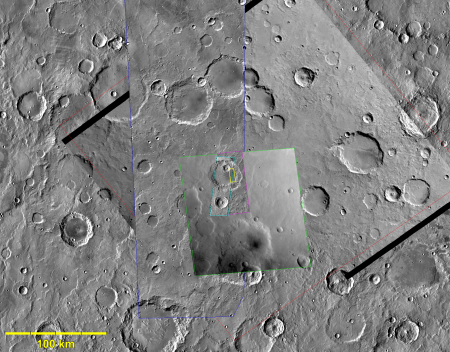A spot on Mars, as seen by different orbiters over the past half century

The science team of Mars Reconnaissance Orbiter (MRO) have assembled a collection of images of the same location on Mars that were taken by different Martian orbiters, beginning with the first fly-by by Mariner 4 in 1965 and ending with MRO’s HiRise camera. The image on the right, reduced in resolution to post here, shows these images superimposed on that location, with resolutions ranging from 1.25 kilometers per pixel (Mariner 4) down to 50 meters per pixel (MRO).
This mosaic essentially captures the technological history of the first half century of space exploration in a single image. Mariner 4 was only able to take 22 fuzzy pictures during its fly-by. Today’s orbiters take thousands and thousands, with resolutions so sharp they can often identify small rocks and boulders.
The mosaic also illustrates well the uncertainty of science. When Mariner 4 took the first pictures some scientists thought that there might be artificially built canals on Mars. Instead, the probe showed a dead cratered world much like the Moon. Later images proved that conclusion to be wrong as well, with today’s images showing Mars to be a very complex and active world, with a geological history both baffling and dynamic. Even now, after a half century of improved observations, we still are unsure whether life there once existed, or even if exists today.
On Christmas Eve 1968 three Americans became the first humans to visit another world. What they did to celebrate was unexpected and profound, and will be remembered throughout all human history. Genesis: the Story of Apollo 8, Robert Zimmerman's classic history of humanity's first journey to another world, tells that story, and it is now available as both an ebook and an audiobook, both with a foreword by Valerie Anders and a new introduction by Robert Zimmerman.
The print edition can be purchased at Amazon or from any other book seller. If you want an autographed copy the price is $60 for the hardback and $45 for the paperback, plus $8 shipping for each. Go here for purchasing details. The ebook is available everywhere for $5.99 (before discount) at amazon, or direct from my ebook publisher, ebookit. If you buy it from ebookit you don't support the big tech companies and the author gets a bigger cut much sooner.
The audiobook is also available at all these vendors, and is also free with a 30-day trial membership to Audible.
"Not simply about one mission, [Genesis] is also the history of America's quest for the moon... Zimmerman has done a masterful job of tying disparate events together into a solid account of one of America's greatest human triumphs."--San Antonio Express-News

The science team of Mars Reconnaissance Orbiter (MRO) have assembled a collection of images of the same location on Mars that were taken by different Martian orbiters, beginning with the first fly-by by Mariner 4 in 1965 and ending with MRO’s HiRise camera. The image on the right, reduced in resolution to post here, shows these images superimposed on that location, with resolutions ranging from 1.25 kilometers per pixel (Mariner 4) down to 50 meters per pixel (MRO).
This mosaic essentially captures the technological history of the first half century of space exploration in a single image. Mariner 4 was only able to take 22 fuzzy pictures during its fly-by. Today’s orbiters take thousands and thousands, with resolutions so sharp they can often identify small rocks and boulders.
The mosaic also illustrates well the uncertainty of science. When Mariner 4 took the first pictures some scientists thought that there might be artificially built canals on Mars. Instead, the probe showed a dead cratered world much like the Moon. Later images proved that conclusion to be wrong as well, with today’s images showing Mars to be a very complex and active world, with a geological history both baffling and dynamic. Even now, after a half century of improved observations, we still are unsure whether life there once existed, or even if exists today.
On Christmas Eve 1968 three Americans became the first humans to visit another world. What they did to celebrate was unexpected and profound, and will be remembered throughout all human history. Genesis: the Story of Apollo 8, Robert Zimmerman's classic history of humanity's first journey to another world, tells that story, and it is now available as both an ebook and an audiobook, both with a foreword by Valerie Anders and a new introduction by Robert Zimmerman.
The print edition can be purchased at Amazon or from any other book seller. If you want an autographed copy the price is $60 for the hardback and $45 for the paperback, plus $8 shipping for each. Go here for purchasing details. The ebook is available everywhere for $5.99 (before discount) at amazon, or direct from my ebook publisher, ebookit. If you buy it from ebookit you don't support the big tech companies and the author gets a bigger cut much sooner.
The audiobook is also available at all these vendors, and is also free with a 30-day trial membership to Audible.
"Not simply about one mission, [Genesis] is also the history of America's quest for the moon... Zimmerman has done a masterful job of tying disparate events together into a solid account of one of America's greatest human triumphs."--San Antonio Express-News


Don’t want to go all dome-over-the-Earth, but what sort of weight is given to that scientist who believes there were past nuclear explosions, on Mars? (John Brandenburg)